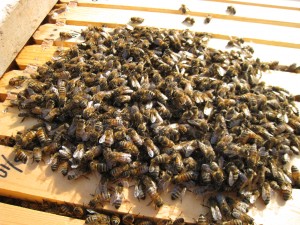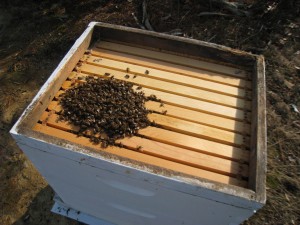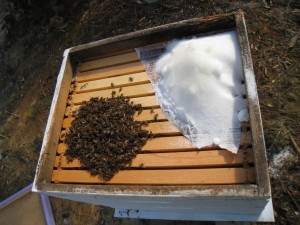As mentioned back in October, I generally let my bees alone until mid-January, when I wait for a day that reaches the upper 40’s and try to get out and look at as many hives as I can! The main goal at this point is to make sure that the cluster is surrounded by honey. We’ll probably have some long, cold weeks over the next two months and it’s important to make sure your bees have something they can nibble on (at the edge of the cluster) to keep the cluster fed (and therefore warm.) But, although it is hard to believe, you hear local beekeepers, every Spring, talking about Dead-out’s (a dead hive) with all of the bees face down in the comb, balled up in the hive, with lots of honey stores 4 inches away! Effectively, they went through a cold stretch where they ate up all of the nearby honey and it never warmed up enough to move the cluster – so they starved/froze to death! By making sure your bees have honey nearby in January, you are doing something to prevent this from happening.
My first goal was to check the hives at home (in the Wilton Apiary). Everyone looked great here but the continuing oddity was the Larry Hive. These guys come out with a vengeance when it breaches 42 or so. They have been doing this all Winter. At first, it made me think the other hives and double nuc’s were suffering, but it is clear to me that these ladies have a genetic trait that I do not have in my other hives. On the one hand, all of this activity might mean they need more food. On the other hand, it stands to reason that these gals will be out on the pollen and nectar first, during the cool days of early Spring. I’ll probably build a Nuc off of this hive or split it, to push these genes to some of my other apiaries.
Then, on to my two problem hives at the Mountcastle Apiary. During my spot check in early January, I checked the weight of the hives and cracked the inner cover on both of the hives at this new out yard. Per the earlier post, I had concerns about both of these hives.
My first task was to break the Albo Hive open. I expected them to be dead or nearly dead. I could then drop a super from this hive (full of honey) on the Westover Hive to give it some more food (in case it needed it.) To my surprise (and glee), the daggone hive had a nice sized ball of bees in it. I have never broken a hive down to the cluster before, usually taking a super or two off and looking down through the frames. I see now that this is not a good method if a hive appears to be failing. This hive was plenty strong. But, it did have a big problem. The cluster had formed on 4 frames directly against the southern side of the hive (probably for the warmth.) But, the frames to their north and directly above them were very low on capped honey. Time for some re-arranging!
I moved the frames one slot to the north and dropped a fully capped frame of honey on both side of it. I then pushed 4 more fully capped frames to directly above them. This worked well, except that they were very pissed. I had a bunch of bees all over me. Unfortunately, a couple stuck their stingers in my gloves and died, but the rest made their way back into the hive once I finished my business.
I then moved over to the Westover Hive to see if they were still in the upper deep. Of course, they were. The cluster had contracted by a couple of inches (radius), which made sense as the temps were higher when I looked earlier this month. I decided to feed these gals, as I am a big fan of this hive. It is from the tough little swarm that I picked up last April. I did the ‘lazy’ Mountain Camp method, pouring out sugar on a sheet of newspaper and then spritzing it with water (while I shield the bees with another sheet of newspaper, so I would not get them wet) until the sugar was good and damp. I had an old hive that was rotting along the edges, so I had cut it into several 1 inch spacers, to make room for this kind of situation.
All in all, this was a great day. I checked on a couple of other hives, which all looked good. Except for the double Nuc’s, I will next check in on them in February, when I might start a little feeding!



